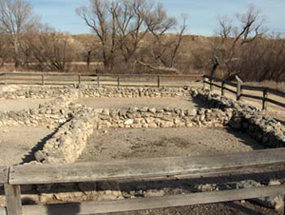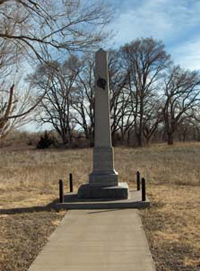Preserving Kansas History
1906 – 2010

In 1902, Kansas Daughters began their dream of service to Kansas history by kicking off a campaign to place markers along the Santa Fe Trail in the state. They secured red granite boulders of varying sizes for the markers, at a cost of about $16 per boulder. At that time, there were only around 300 members in the entire state, so help from the communities was essential. By 1906, the Daughters had enough money for 70 markers and began to arrange their dedication.
One hundred years later, then State Regent Shirley S. Coupal chose as her project to survey all the DAR markers on the Santa Fe Trail in Kansas and make whatever repairs were necessary to allow them to proudly stand for another century. Bases were repaired and lettering was refurbished.
1922 – 2013

The Kansas Society Daughters of the American Revolution have owned the 60′ by 500′ tract of land containing the pueblo ruins, known as El Cuartelejo, since 1922. Situated in Scott County, the site is surrounded by Lake Scott State Park. The site is unique in that the Pueblo settlement, quite active from about 1650 until the 1680s, predates the settlement of Europeans in Kansas. By 1727, the settlement was unoccupied and fell to ruin.
Kansas Society Daughters raised funds to place a monument marking the site and for its upkeep. A 12’ gray granite obelisk was placed on the site. Four granite cornerstones, engraved with DAR, mark the property lines. On October 25, 1964, a gala pageant was held, celebrating the designation of the property as a National Historic Landmark. Temporary home to several Indian tribes, the site is the northmost site of Pueblo culture in North America.

In 1970, the Kansas State Historical Society was granted an easement for the construction, improvement, operation, and maintenance of the El Cuartelejo Pueblo for the Kansas Society DAR. The Kansas Society DAR takes pride in its eighty-five-year commitment to protecting the El Cuartelejo Pueblo ruins.
In 2005, Kansas Society DAR, Kansas State Historical Society, and the Kansas Department of Wildlife and Parks formulated plans for an interpretive center to protect the site and furnish an interpretive experience for visitors at El Cuartelejo. The project continues. In 2013, the Kansas Society DAR transferred the property to the state of Kansas for further development and preservation.
1929 – 2010
In 1911, the Daughters of the American Revolution established a national committee known as the National Old Trails Road Committee whose work was, primarily, to establish the Old Trails Road as a great National Memorial Highway. The Old Trails Road had traversed twelve states from Maryland to California, traveled by pioneers to points west.

After a variety of designs were considered, the now-familiar pioneer mother statue was decided upon. Monuments were erected by state organizations of the Daughters of the American Revolution in each of the twelve states through which the National Old Trails Road passes, culminating in the week of April 19, 1929, with the twelfth monument dedication at Bethesda, Maryland. The marking of the ocean-to-ocean highway, honoring the pioneer mothers of covered wagon days, completed the memorialization of the trail of a young nation as they crossed the Allegheny Mountains to make their homes in the great western wilderness.
In the twelve states, the DAR chapters that are located nearby are known as guardian chapters of the Madonna of the Trail and may, where indicated, provide landscaping, cleaning, and whatever may be needed to maintain the statues.
Photos Courtesy of KSDAR Members


